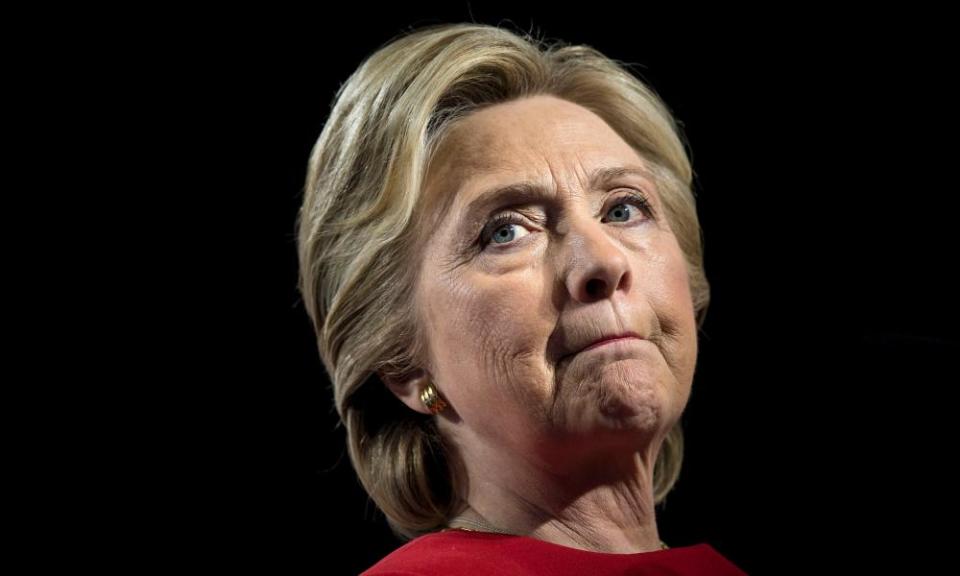Hillary Clinton's book has a clear message: don't blame me | Thomas Frank
Hillary Clinton simply cannot escape her satisfied white-collar worldview. This prevents her from understanding the events of 2016

How do you lose the presidency to a man like Donald Trump? He was the most unpopular presidential candidate of all time, compounding blunder with blunder and heaping gaffe upon gaffe. Keeping him from the Oval Office should have been the single-minded mission of the Democratic party. And it should have been easy for them.
Instead they lost, and now their 2016 candidate Hillary Clinton comes before us to account for this monumental failure, to tell us What Happened. Unfortunately, her new book is less an effort to explain than it is to explain away.
No real blame ever settles anywhere near Clinton’s person. And while she wrestles gamely with the larger historical question of why the party of the people has withered as inequality grows, she never offers a satisfying answer. Instead, most of the blame is directed outward, at familiar suspects like James Comey, the Russians and the media.
Still, by exercising a little discernment, readers can find clues to the mystery of 2016 here and there among the clouds of blame-evasion and positive thinking.
Start at the beginning: why did Hillary Clinton run for president? “[B]ecause I thought I’d be good at the job,” she writes. Then, 13 pages later: “It was a chance to do the most good I would ever be able to do.”
A would-be do-gooder needs problems to solve, of course, and so Clinton says she turned next to the people who knew what was wrong. “I started calling policy experts,” she writes, “reading thick binders of memos, and making lists of problems that needed more thought.” Lists of problems and solutions are everywhere; reeling them off one after another is one of her favorite rhetorical devices, her way of checking the boxes and letting everyone know that she cares.
Proceeding in this rational, expert-sanctioned way, Hillary Clinton set out resolutely on the road to oblivion.
She seems to have been almost totally unprepared for the outburst of populist anger that characterized 2016, an outburst that came under half a dozen different guises: trade, outsourcing, immigration, opiates, deindustrialization, and the recent spectacle of Wall Street criminals getting bailed out. It wasn’t the issues that mattered so much as the outrage, and Donald Trump put himself in front of it. Clinton couldn’t.
To her credit, and unlike many of her most fervent supporters, Hillary Clinton doesn’t deny that this web of class-related problems had some role in her downfall. When she isn’t repeating self-help bromides or calumniating the Russians she can be found wondering why so many working-class people have deserted the Democratic party.
This is an important question, and in dealing with it Clinton writes a few really memorable passages, like her description of a grotesque campaign stop in West Virginia where she was protested by a crowd that included the former CEO of the company that owned the Upper Big Branch mine, where 29 coal miners died in 2010.
But by and large, Clinton’s efforts to understand populism always get short-circuited, probably because taking it seriously might lead one to conclude that working people have a legitimate beef with her and the Democratic party.
Countless inconvenient items get deleted from her history. She only writes about trade, for example, in the most general terms; Nafta and the TPP never. Her husband’s program of bank deregulation is photoshopped out. The names Goldman Sachs and Walmart never come up.
Besides, to take populism seriously might also mean that Bernie Sanders, who was “outraged about everything,” might have had a point, and much of What Happened is dedicated to blasting Sanders for challenging Clinton in the Democratic primaries. Given that he later endorsed her and even campaigned for her, this can only be described as churlish, if not downright dishonest.
That Clinton might have done well to temper her technocratic style with some populist outrage of her own only dawns on her towards the end of the book, by which point it is too late.
Not to mention impossible. Hillary Clinton simply cannot escape her satisfied white-collar worldview – compulsively listing people’s academic credentials, hobnobbing with officers from Facebook and Google, and telling readers how she went to Davos in 1998 to announce her philosophy.
And then, in her concluding chapter, returning to her beloved alma mater Wellesley College and informing graduates of that prestigious institution that, with their “capacity for critical thinking” (among other things) they were “precisely what we needed in America in 2017.”
I wish it were so. I wish that another crop of elite college grads were what we needed. I wish Hillary’s experts and her enlightened capitalist friends could step in and fix this shabby America we inhabit today, where racists march in the streets and the Midwest falls apart and cops shoot motorists for no reason and a blustering groper inhabits the White House.
I wish it were all a matter of having a checklist of think-tank approved policy solutions. But I know for sure it isn’t. And voters knew that, too.
Thomas Frank is a Guardian US columnist

